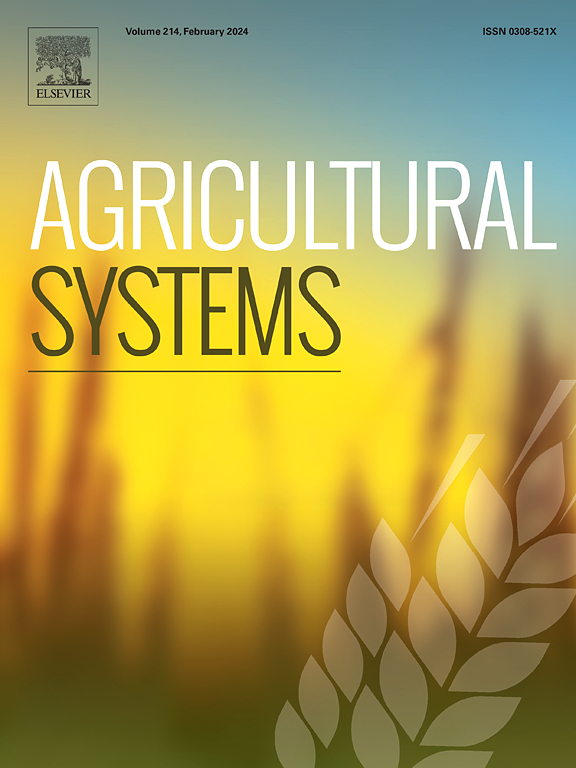Nitrogen fertilizer and high-protein varieties work together to increase wheat grain protein concentration and yield
IF 6.1
1区 农林科学
Q1 AGRICULTURE, MULTIDISCIPLINARY
引用次数: 0
Abstract
Context
Meeting humanity's growing grain protein needs is the top priority for food production, and although the formation of grain protein in plants is a complex and integrated process, some specific crop management practices may play a dominant role. Few studies have been data-driven to quantitatively assess the benefits of crop management practices on wheat grain protein on a national scale.
Objectives
To fill this gap, we quantified the total national benefits of crop management practice on wheat grain protein and estimated for the first time the productivity of China's wheat grain protein in 2030.
Methods
A meta-analysis was performed by compiling 5819 pairs of observations related to crop management practices and wheat grain protein, and a large-scale farmer survey was conducted from 2010 to 2020 to understand the current status of smallholder wheat production and to predict further trends using the Random Forest model.
Results and conclusions
Results showed that the concentration and yield of grain protein increased by 2.6–6.9 % and 9.4–13.2 % for topdressing, and 9.1 % and 6.7 % for high-protein variety, but decreased by 5.3 % and 8.5 % for optimized nitrogen (N) fertilizer rate, respectively. The RF model showed that eleven key predictors from crop management practices and soil-climate factors accounted for 84 % of the effect on wheat grain protein, with N fertilizer management and wheat varieties making the largest contributions. Using this data-driven approach, we estimated that China's grain protein production would increase from 18.6 to 19.8 Mt. with a 14 % reduction in N use through optimized N fertilizer management and the use of higher gluten wheat varieties under future climate change. Optimized N fertilizer management and the adoption of high-protein variety are the most important approaches to simultaneously improve grain yield and protein concentration.
Significance
Our findings fill a gap in national estimates of wheat grain protein production and highlight the importance of strategic crop management practices for nutritional security.

氮肥与高蛋白品种共同作用,可提高小麦籽粒蛋白质浓度和产量
满足人类不断增长的粮食蛋白质需求是粮食生产的首要任务,尽管植物中粮食蛋白质的形成是一个复杂而综合的过程,但一些特定的作物管理措施可能起主导作用。很少有研究以数据为基础,在全国范围内定量评估作物管理做法对小麦谷物蛋白质的好处。为了填补这一空白,我们量化了作物管理实践对小麦籽粒蛋白质的国家总效益,并首次估算了2030年中国小麦籽粒蛋白质的生产力。方法收集5819对与作物经营方式和小麦籽粒蛋白相关的观测数据,进行meta分析,并在2010 - 2020年进行大规模农户调查,了解小农小麦生产现状,并利用随机森林模型预测未来趋势。结果与结论结果表明,追肥处理可使籽粒蛋白质浓度和产量分别提高2.6 ~ 6.9%和9.4 ~ 13.2%,高蛋白品种提高9.1%和6.7%,氮肥施用量优化后籽粒蛋白质浓度和产量分别降低5.3%和8.5%。RF模型显示,来自作物管理方式和土壤气候因子的11个关键预测因子对小麦籽粒蛋白质的影响占84%,其中氮肥管理和小麦品种贡献最大。利用这种数据驱动的方法,我们估计在未来气候变化下,通过优化氮肥管理和使用高筋小麦品种,中国谷物蛋白质产量将从18.6亿吨增加到19.8亿吨,氮肥使用量减少14%。优化氮肥管理和选用高蛋白品种是同时提高籽粒产量和蛋白质浓度的重要途径。我们的发现填补了国家小麦籽粒蛋白质产量估算的空白,并强调了战略性作物管理实践对营养安全的重要性。
本文章由计算机程序翻译,如有差异,请以英文原文为准。
求助全文
约1分钟内获得全文
求助全文
来源期刊

Agricultural Systems
农林科学-农业综合
CiteScore
13.30
自引率
7.60%
发文量
174
审稿时长
30 days
期刊介绍:
Agricultural Systems is an international journal that deals with interactions - among the components of agricultural systems, among hierarchical levels of agricultural systems, between agricultural and other land use systems, and between agricultural systems and their natural, social and economic environments.
The scope includes the development and application of systems analysis methodologies in the following areas:
Systems approaches in the sustainable intensification of agriculture; pathways for sustainable intensification; crop-livestock integration; farm-level resource allocation; quantification of benefits and trade-offs at farm to landscape levels; integrative, participatory and dynamic modelling approaches for qualitative and quantitative assessments of agricultural systems and decision making;
The interactions between agricultural and non-agricultural landscapes; the multiple services of agricultural systems; food security and the environment;
Global change and adaptation science; transformational adaptations as driven by changes in climate, policy, values and attitudes influencing the design of farming systems;
Development and application of farming systems design tools and methods for impact, scenario and case study analysis; managing the complexities of dynamic agricultural systems; innovation systems and multi stakeholder arrangements that support or promote change and (or) inform policy decisions.
 求助内容:
求助内容: 应助结果提醒方式:
应助结果提醒方式:


